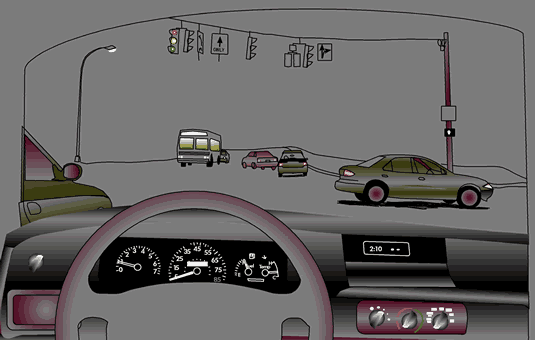The Long and Lighted Road: Lighting and Driving
 |
| Lighting is an important part of the information system provided to drivers and pedestrians. Click in the image above for additional information about lighting and driving. |
The act of driving brings with it a variety of needs. We need to see:
- the road
- oncoming cars and their signals
- actual and potential obstacles
- indicators for speed and engine conditions
- maps
- traffic signals
- road signs and markers
We have dome and map lights, and illuminated instrument clusters, indicators, radios and temperature controls. We rely on headlamps, flashers, turn signals, brake lights, the glow of the radio. Each little flash, each bright signal, affects how we drive, our safety, and our gas mileage. We may take for granted the tiny light that tells us we need gas, but hours of research have gone into what kind of lighting is most useful and safest for the nearly 185 million drivers on U.S. roads, their passengers, and for pedestrians.
Among the important questions that we can consider when we think about lighting and driving are:
- What lights are best for headlights?
- What is the most efficient and visible way to light the dashboard?
- How do roadway lighting and signs affect drivers and pedestrians?
- What are the best ways to illuminate signs?
Automotive engineers, scientists, and designers research the answers to these questions and others that involve lighting. Some basic concerns are:
- glare from interior lights
- glare from oncoming head lights
- brightness and its relation to brake light and traffic signal response times
- energy efficiency in automotive and roadway lighting
- lighting and its effect on peripheral vision
In a 1999 paper given at the Commission Internationale de l'Éclairage conference in Warsaw, Poland, Wout van Bommel summarized directions in transportation lighting research over the past 80 years from a focus exclusively on visibility to one that considers visual comfort, safety and security of pedestrians, and optimum traffic flow on increasingly crowded roads. These factors will continue to optimized as new concerns develop, including the energy and environmental impacts of new lighting technologies (see the links page for additional information). This issue of Lighting Futures will describe some of these trends and concerns.
Human factors in automotive lighting
How do people interact with machinery? That's the question the study of human factors tries to answer. In cars, human factors scientists examine both physical and psychological elements as they design and refine car seats, steering wheels, the distance between controls. They also study very carefully how people use and react to roadway lighting, lighting inside the cars they drive, and the lights they see on other cars.
What color lights do people react to most quickly? Is green light more distracting than yellow on a dashboard? Do light-emitting diodes provide sufficient light for signals? Are passenger reading lights distracting to the driver? Does the color of a headlight affect the quality of a driver's vision? How does headlight color affect drivers in oncoming cars?
These are only a few of the questions that human factors scientist study and answer as cars are designed. As new technologies develop, automobile human factors researchers see how they can be incorporated into cars.
Human factors in driving is also becoming more important as the segment of aging drivers grows. Automotive lighting will have to keep up with the vision needs of older drivers. Older drivers are more sensitive to glare, while requiring more light to see. Glasses to correct myopia (nearsightedness) might also cause problems in viewing the dashboard. These conditions have to be addressed because so many drivers are aging into eye problems.
Current and emerging technologies
Automotive lighting requires sources that combine brightness, small size, and energy efficiency. Existing technologies are refined and redesigned for different applications as cars themselves are redesigned, and as new technologies become options for interior and exterior automotive lighting, roadway lighting, and traffic signals.
Fiber optic and distributive lighting is effective for dashboard and other interior lights. A single source can send light to several endpoints through tiny fiber optic cables. Higher-end vehicles are beginning to use distributive lighting to illuminate features not directly associate with driving, such as cup holders, door locks, and window controls. Distributive lighting for headlamps and automotive signals is also being examined with high brightness light sources.
Incandescent lamps of various kinds have long been used in head lights, brake lights, dome lights, and traffic signals. They are less energy efficient than many sources and require filters to provide color. They can operate well at high temperatures and are inexpensive and easy to manufacture. However, they also have relative shorter lives than other light sources, and generate significant heat. New technologies have been replacing incandescent lamps in many automotive applications.
LEDs (light-emitting diodes) have long been sources for indicator lights. The tiny, bright, solid-state light sources are long-lived and energy efficient. LEDs have become a popular source in many automotive and traffic signals for the same reasons. However, the output of many types of LEDs used in transportation applications is dependent upon temperature.
HID (high-intensity discharge) lamps provide high light output using less energy that incandescent lamps. These sources have been used in roadway lighting installations for many years and are growing in popularity as light sources for headlamps. HID lamps require ballasts to operate.
Neon lighting provides exterior lighting while consuming less energy and less space than typical incandescent lighting for signal and brake lights. Neon is relatively expensive, though, and requires additional electronic circuitry to operate.
Back | Forward
Introduction | Interior | Headlights | Vehicle Signals | Roadway | Traffic Signals | Links | Credits


